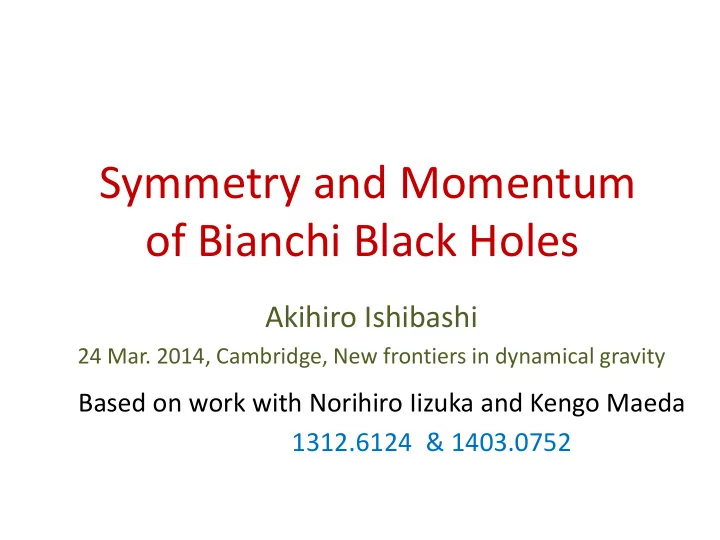

Symmetry and Momentum of Bianchi Black Holes Akihiro Ishibashi 24 Mar. 2014, Cambridge, New frontiers in dynamical gravity Based on work with Norihiro Iizuka and Kengo Maeda 1312.6124 & 1403.0752
Instability of AdS and singularity theorems • Singularity (incomplete causal geodesic) must form under the conditions of 1. Convergence (generic & energy conditions) 2. Global structure (causality or Cauchy surface) 3. Strong-gravity (trapped set) World line of a particle
A key of the proof q • Globally hyperbolic sub-region that contains an endless timelike curve null-convergence & trapped surface -- guarantee the existence of the maximal length curve among all causal curves p from p q. and the maxim is attained by a timelike geodesic • AdS is non-globally hyperbolic
To get a desired maximal length curve, one may think of double covering of the physical, asymptotically AdS spacetime to construct a globally hyperbolic unphysical spacetime w/ compact Cauchy surface. Attempt to show a singularity theorem in the unphysical spacetime rather than in the physical spacetime.
Globally hyperbolic spacetime identify w/ compact Cauchy surface Asympt. AdS bulk Copy identify glue them together at conformal boundary Conformal infinity Can one apply the argument of maximum length causal curve?
Under the standard boundary conditions isometric to an open set of the Einstein-Static Universe (e.g. Dirichlet conditions) The convergence (generic) condition is NOT satisfied for timelike geodesics at (AdS infinity) -- cannot lead a contradiction! How big are the stability islands on the turbulent ocean? Bizon’s talk The answers may also be related to what type of (time-dependent) boundary conditions one considers
Symmetry and Momentum of Bianchi Black Holes
Motivation: AdS/CMP AdS-black hole superconductor Conductivity calculation Momentum flow persistent current Realistic model ? Translational symmetry broken Lattice structure Recent efforts – break translational invariance -- lattice structure introduced by chemical potential or scalar field Hartnoll-Hofman2012, Iizuka-Maeda 2012, Horowitz – Santos –Tong 2012, 2013 … etc
-- wish to construct a holographic superconductor in which a current flows without dissipation in direction of lattice where translational invariance is broken.
In asymptotically flat case, if an asymmtric black hole rotates along direction of no symmetry, it emits gravitational waves and settles down to a static spacetime. In asymptotically AdS case, gravitational radiation will be reflected by AdS boundary, and the geometry could possibly approach ・ an equilibrium state with no axisymmetry, or ・ state of forever dynamical See e.g. Maliborski’s talks The event-horizon itself does not rotate but some radiation (or matter fields) outside the horizon may carry the (angular) momentum. e.g. Dias-Horowitz-Santos 2011
Closely related to the rigidity theorem: “stationary, rotating implies axisymmetric” Hawking 72, Hollands-AI-Wald 07 Moncrief-Isenberg 08 Key requirements: • Weak energy conditions • Compact Horizon cross-sections • Analyticity Claims: (1) The event horizon is a Killing horizon (2) if rotating then axisymmetric
Can a black hole have momentum along a direction of no translational invariance? If possible, in what circumstances?
This talk • We consider 5-dimesional AdS black hole whose horizon cross-sections are given by a Bianchi (homogeneous anisotropic) geometry Bianchi geometry: • 3 Killing vectors Structure constant classifies the Bianchi type • Invariant 1-forms
Type VII0 and helical structure No translational invariance along - direction Discrete symmetry: Lattice structure is introduced Donos-Hartnoll 2012, Donos- Guantlett 2012
Metric ansatz (i) Einstein equations reduce to a set of ODEs for (ii) Event horizon located at (iii) At asymptotic region: impose (iv) translational invariance along x- dir. recovered when
On the horizon Null vector on the horizon: NOT Killing unless Null convergence (weak energy) condition implies or on the horizon We seek for solutions of Case (I) and on Case (II) and on
Lattice on Gravity dual in Case (I) for convenience we set: : a source for the helical structure
Asymptotic behaviour • Parameters: • Boundary conditions: AdS at infinity:
Solutions: Accordingly to AdS/CFT dictionary: This solution describes a persistent current/momentum along the direction of lattice, no dissipation
Consistent to Superfluid dynamics by Landau Tisza
Gravity dual in Case (II): on Asymptotic condition: with so that it is normalisable
Numerical solutions Outside the horizon: symmetry broken On the horizon: symmetry restored and momentum flows
• In this model weak energy condition holds and Bianchi VII0 manifold can be compactified --- requirements of the rigidity theorem This solution suggests the possibility of a regular rotating black hole which is not analytic at the horizon, thereby evading the rigidity theorem. c.f. evading the rigidity by considering non-compact horizon See Figueras-Wiseman 2012 c.f. charged Multi-black holes with non-smooth horizons See, e.g., Welch 1995
Recommend
More recommend